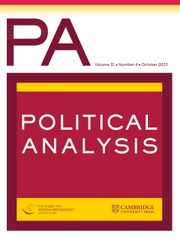Article contents
Explicit Bayesian Analysis for Process Tracing: Guidelines, Opportunities, and Caveats
Published online by Cambridge University Press: 15 May 2017
Abstract
Bayesian probability holds the potential to serve as an important bridge between qualitative and quantitative methodology. Yet whereas Bayesian statistical techniques have been successfully elaborated for quantitative research, applying Bayesian probability to qualitative research remains an open frontier. This paper advances the burgeoning literature on Bayesian process tracing by drawing on expositions of Bayesian “probability as extended logic” from the physical sciences, where probabilities represent rational degrees of belief in propositions given the inevitably limited information we possess. We provide step-by-step guidelines for explicit Bayesian process tracing, calling attention to technical points that have been overlooked or inadequately addressed, and we illustrate how to apply this approach with the first systematic application to a case study that draws on multiple pieces of detailed evidence. While we caution that efforts to explicitly apply Bayesian learning in qualitative social science will inevitably run up against the difficulty that probabilities cannot be unambiguously specified, we nevertheless envision important roles for explicit Bayesian analysis in pinpointing the locus of contention when scholars disagree on inferences, and in training intuition to follow Bayesian probability more systematically.
Information
- Type
- Articles
- Information
- Copyright
- Copyright © The Author(s) 2017. Published by Cambridge University Press on behalf of the Society for Political Methodology.
Footnotes
Authors’ note: The authors thank Andrew Bennett, David Collier, Macartan Humphreys, Alan Jacobs, and James Mahoney, as well as four anonymous reviewers and Editor Jonathan Katz, for valuable detailed comments on previous versions of this paper. We are also grateful to Devin Caughey, Gustavo Flores-Macías, Peter Kingstone, Richard Nielsen, Tom Pepinsky, Kenneth Roberts, Andrew Schrank, Ken Shadlen, and participants at the 2015 and 2016 APSA Annual Meetings, LSE’s ID and CP/CPE seminars, MIT’s Political Methodology Research Series, and the 2016 Southwest Mixed-Methods Research Workshop. We dedicate this paper to the memory of Kenneth Fairfield.
Contributing Editor: Jonathan Katz
References
- 89
- Cited by

